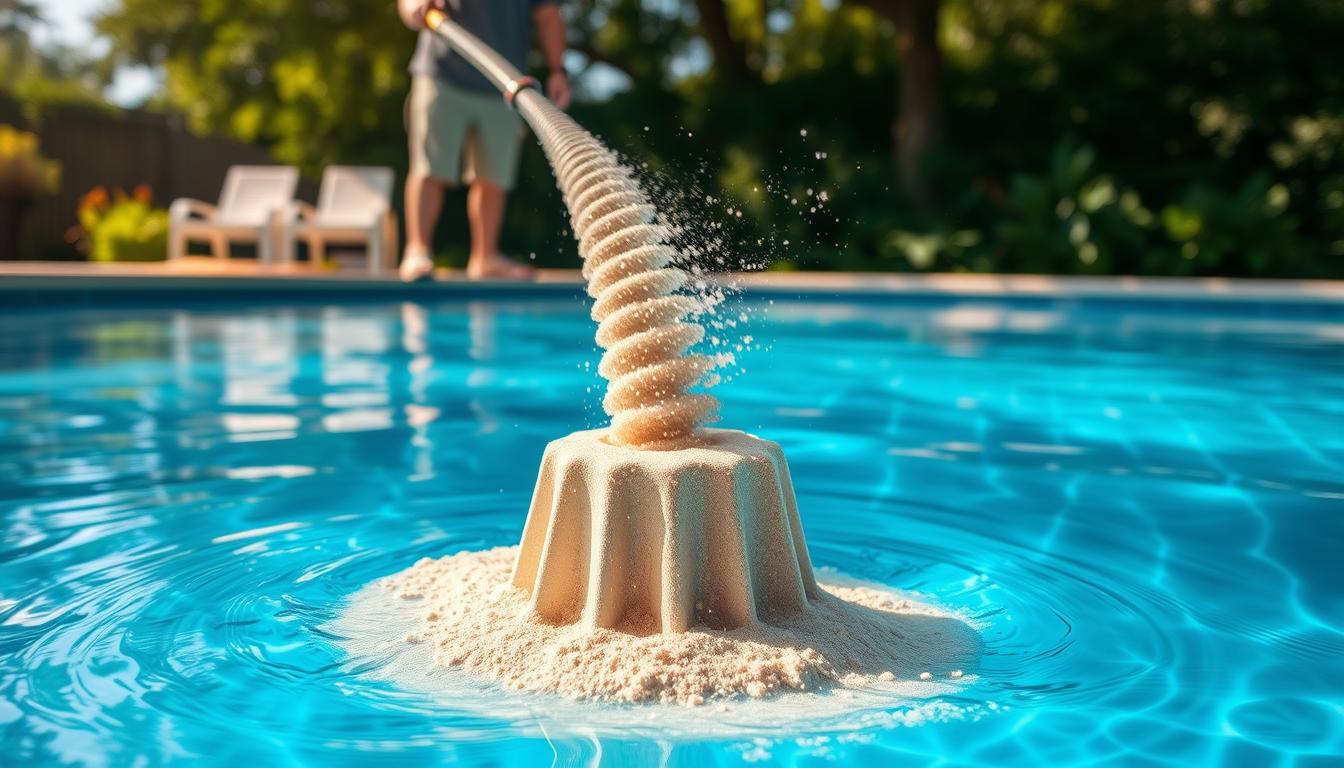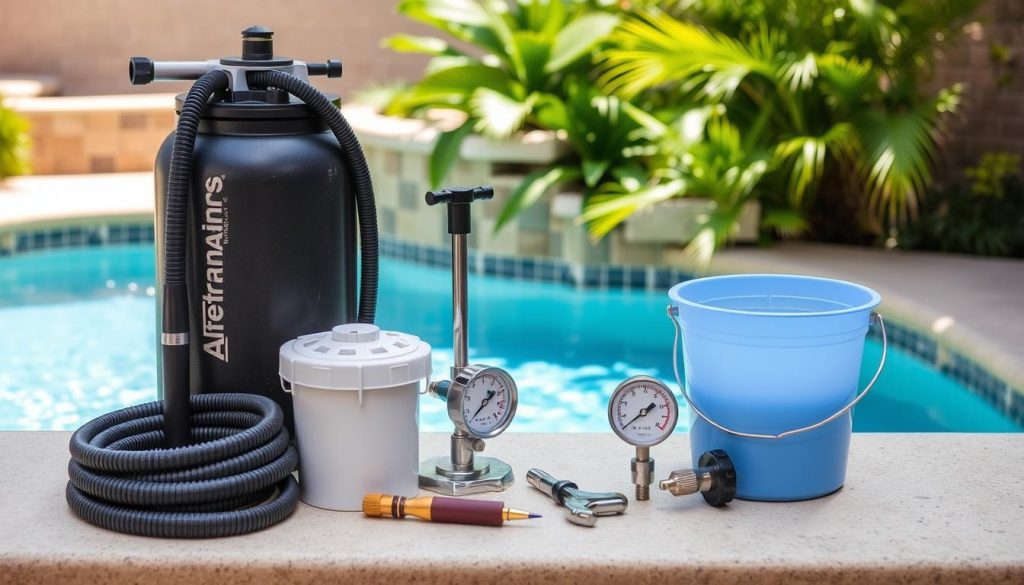
Summer’s here, and it’s time to prep your pool for refreshing swims. Sand filters are popular among pool owners, used in 35% of pools worldwide. These durable filters need regular cleaning to keep your pool water clear.
Neglecting pool maintenance can lead to cloudy, uninviting water. Regular pool filter cleaning ensures a safe and enjoyable swimming experience for everyone.
This guide explores sand filter backwashing and expert pool equipment cleaning techniques. We’ll cover how sand filters work and provide step-by-step instructions for maintenance.
You’ll gain insights into pool filter troubleshooting, pool filter replacement, and pool filter repair. Our guide will help you tackle any sand filter cleaning challenge.
By the end, you’ll have the know-how to keep your swimming pool sand filters in top shape. Your pool will remain a sparkling oasis all summer long.
Understanding Sand Pool Filters
Sand pool filters are popular among pool owners. They’re simple, affordable, and effective in keeping pool water clean. Understanding how they work helps maintain your pool’s optimal condition.
These filters ensure your pool stays inviting throughout the swimming season. Knowing when to clean them is crucial for their performance.
How Sand Filters Work
Sand filters use special-grade silica sand to clean pool water. The sand traps debris and impurities as water passes through it. This process removes particles as small as 20 to 40 microns.
A pressure gauge monitors the filter’s efficiency. When pressure rises 25% above baseline, it’s time to backwash. Backwashing removes trapped contaminants and restores the filter’s effectiveness.
Advantages of Sand Filters
Sand filters are durable and long-lasting. With proper care, they can serve you for five to eight years. The sand itself needs replacement every three to five years.
These filters are easy to maintain. A simple backwashing process cleans the sand bed effectively. They’re also cost-effective compared to other filtration systems.
| Filter Type | Lifespan | Maintenance |
|---|---|---|
| Sand Filter | 5-8 years | Backwash when pressure increases by 25% |
| Cartridge Filter | 2-5 years | Clean or replace cartridge as needed |
Signs Your Sand Filter Needs Cleaning
Regular monitoring helps identify when your sand filter needs cleaning. A pressure increase of 7-10 psi indicates significant debris accumulation. This means it’s time to backwash.
Other signs include reduced water flow from return jets and cloudy pool water. Algae growth in the pool also suggests your filter needs attention.
Addressing these issues promptly prevents serious problems. Follow a regular maintenance schedule to keep your pool clean and inviting.
Step-by-Step Guide to Cleaning Your Sand Pool Filter
Regular sand pool filter cleaning is vital for clear water. This guide will help you clean your filter effectively. You’ll keep your pool sparkling clean with these steps.
Gather Necessary Tools and Equipment
Before cleaning, collect all the required tools. You’ll need a backwash hose and sand filter cleaner. Replacement sand and a wrench or pliers may also be necessary.
- Backwash hose
- Sand filter cleaner (if needed)
- Replacement sand (if required)
- Wrench or pliers for tightening clamps and bolts

Backwash the Sand Filter
Start by backwashing the filter. Turn the multiport valve to “Backwash” to reverse water flow. Run the pump for 2-3 minutes until the sight glass water is clear.
This process flushes out dirt and debris from the sand bed. It’s a crucial first step in cleaning your filter.
An increase in the pressure gauge reading of over 8 PSI above the normal operating level indicates it may be time to clean your sand pool filter.
Rinse the Filter
After backwashing, rinse the filter to settle the sand. Set the valve to “Rinse” and run the pump for a minute. This step ensures your filter is ready for optimal performance.
Inspect and Replace Sand if Needed
Check the sand in your filter every 3-5 years. Replace it if it’s dirty, clumped, or has debris that won’t backwash out. Here’s a comparison of sand conditions:
| Sand Needing Replacement | Sand Still Usable |
|---|---|
| Visible dirt and debris | Clean appearance |
| Clumping or hardening | Loose and granular texture |
| Persistent high pressure after backwashing | Pressure returns to normal after backwashing |
After cleaning or replacing sand, reassemble the filter carefully. Ensure all parts are correctly positioned and fitted snugly. Tighten clamps, lids, and bolts to prevent leaks or pressure issues.
Following this guide will help maintain your sand pool filter effectively. You’ll create a clean, healthy swimming environment for your family to enjoy.
Maintaining Your Sand Pool Filter for Optimal Performance
Pool filter maintenance is key for a clean, inviting swimming environment. Check the pressure gauge often. High readings mean a clogged filter that strains the pump.
Backwash your sand filter every few weeks. Do this when the pressure gauge rises 8-10 psi above normal. This keeps your filter working well.
Clean skimmer baskets regularly to prevent blockages. This helps skimmers catch debris before it settles. Keep pool inlets and outlets clear for good water flow.
Consider using an automatic pool cleaner like the Beatbot AquaSense Pro. These robots stir the water, spreading chemicals and heat evenly. They also remove debris from the water’s surface.
Robotic cleaners reduce the workload on your sand filter. This can extend its life and keep your pool equipment working well.
Replace sand in pool filters every five to seven years. This prevents clogging and keeps filtration effective. Follow these tips for a sparkling clean pool.







